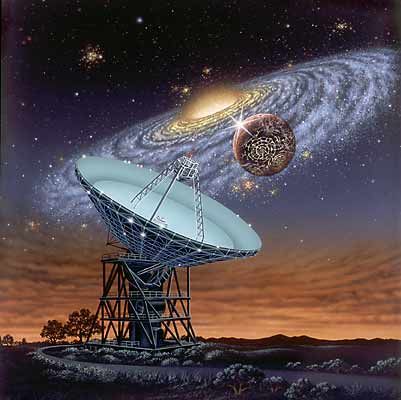| A Thermodynamic Answer to Fermi's
Paradox |
|
According to this line of thinking, the Earth should already have been colonized, or at least visited. But no convincing evidence of this exists. Furthermore, no confirmed signs of intelligence elsewhere have been spotted, either in our galaxy or in the more than 80 billion other galaxies of the observable universe. Hence Fermi's question, "Where the heck is everybody?"
Here's my answer to the Fermi Paradox, which is based on the way life evolves based on thermodynamic principles. Let's start with the following assumptions about life in general (you may notice some familiar aspects).
IF:
THEN:
Burning carbon and using the released energy of combustion is easy and obvious. It will be done fairly early in the life of the presumed intelligent species, well before they accumulate enough scientific knowledge to detect the long-term planetary danger of the carbon dioxide exhaust gases. In our case we have been doing it for over a million years, but figured out the problem of global warming less than a hundred years ago.
By the time the danger is realized, the species will be carbon-dependent - locked into the burning of carbon for energy - trapped in a vicious spiral of thermodynamically-driven self-organization, energy-dependent maintenance of existing physical and social structures, increasing energy dependence, increasing CO₂ production - and increasing planetary heating from the "greenhouse effect".
If there is enough carbon available, the species will become technologically advanced, will send out signals for a short while and will then go extinct due to an inability to adapt to the planet's changing climate. The species will not climb out of its gravity well and fly to the stars, because the energy required will all be soaked up in its own growth, and extinction will happen well before it gets to the Dyson Sphere stage.
Now, I'm probably anthropomorphizing and projecting like crazy, but the whole edifice rests on the fairly banal assumption that our experience is approximately average for an intelligent species. That is, we are not in the least special. Other intelligent life will probably arise under similar circumstances, follow a similar path and fall into a similar hole.
Where is everybody? Well, there are
probably a lot of them out there. But either they
never developed radio, or they did and soon afterwards
all went the same place we're probably going: Poof! Thank
you, physics! Paul
Chefurka
|
| This
article may be reproduced in whole or in part , in any
manner and for any purpose whatsoever, with no
restrictions. |
 The
The